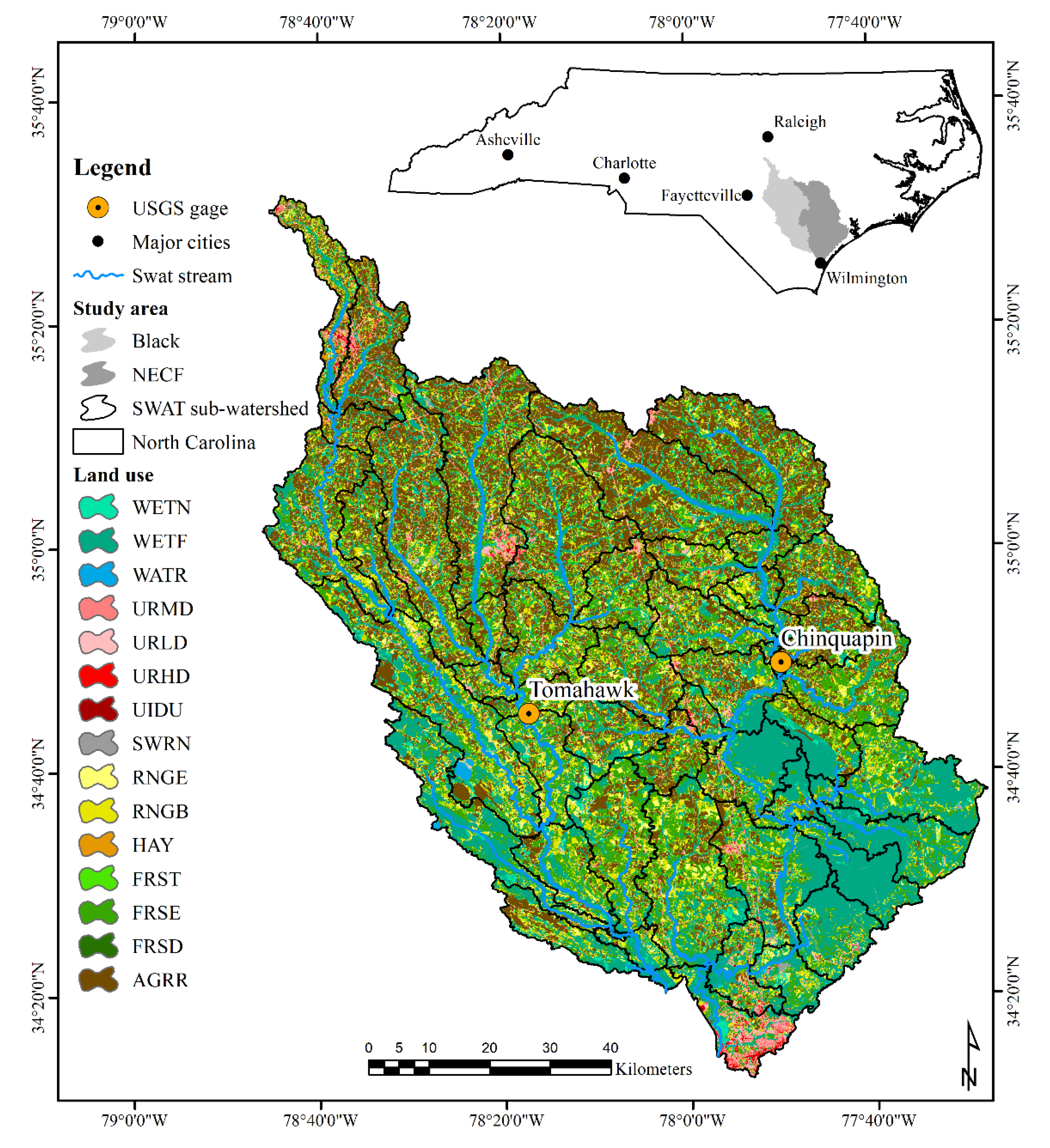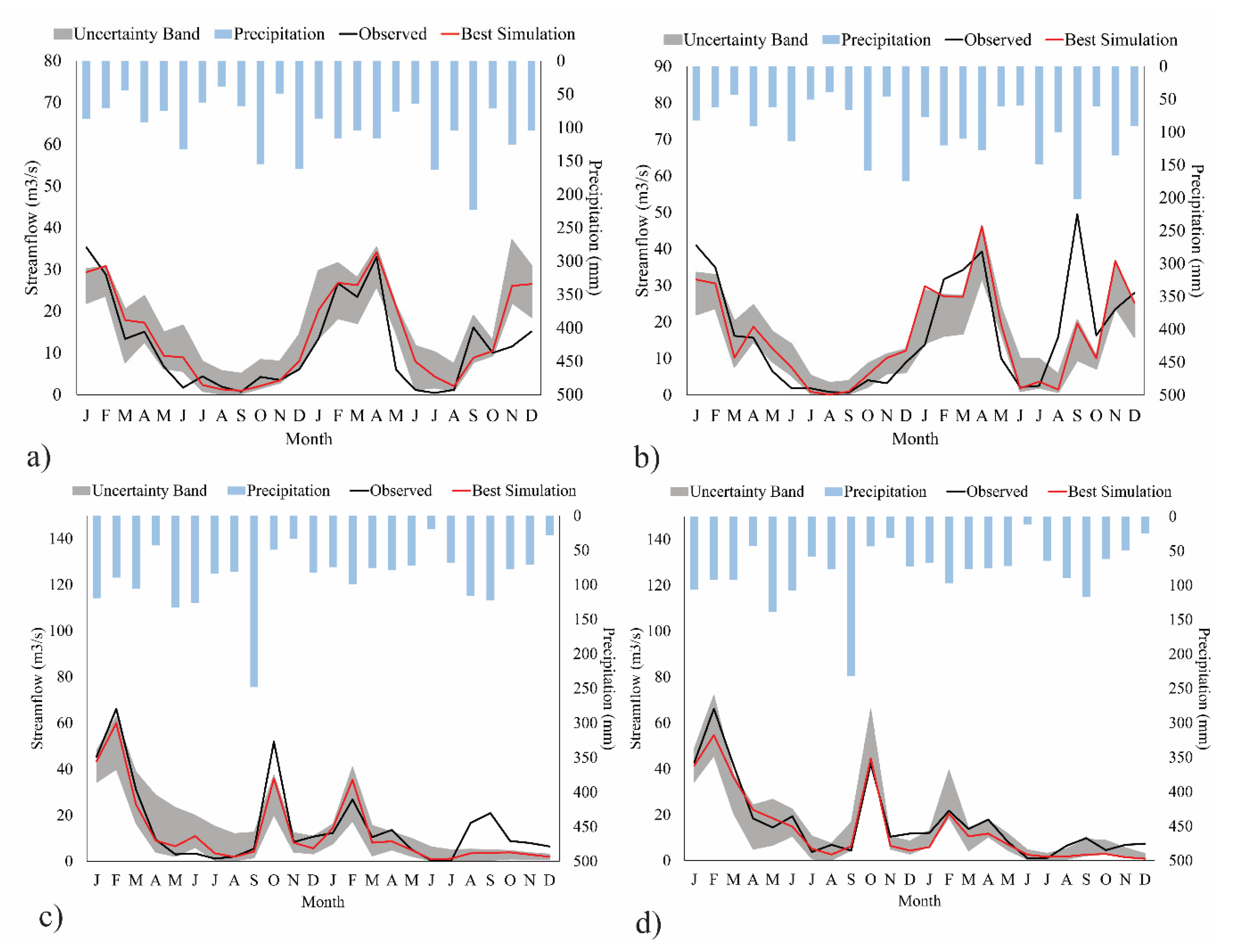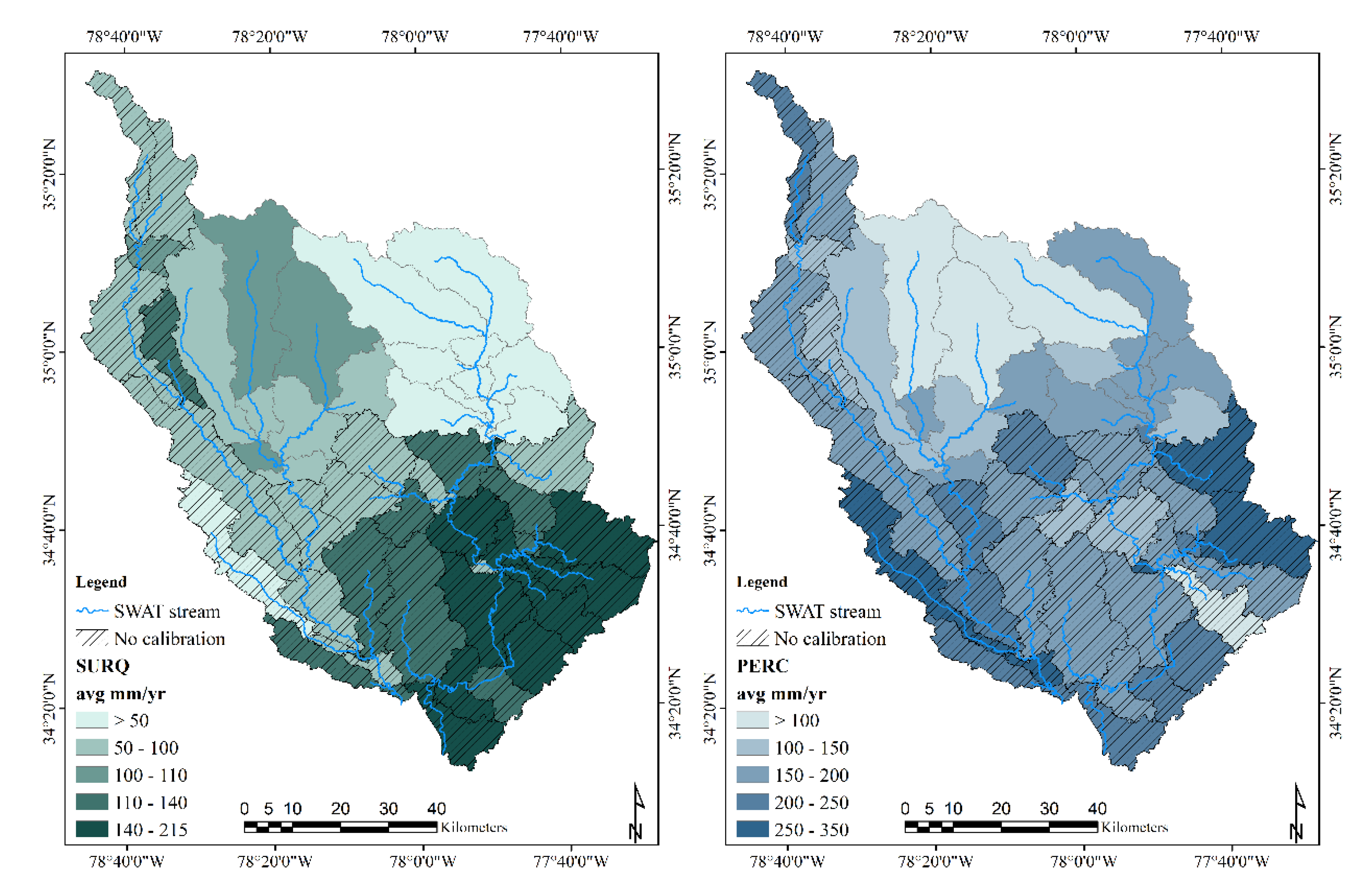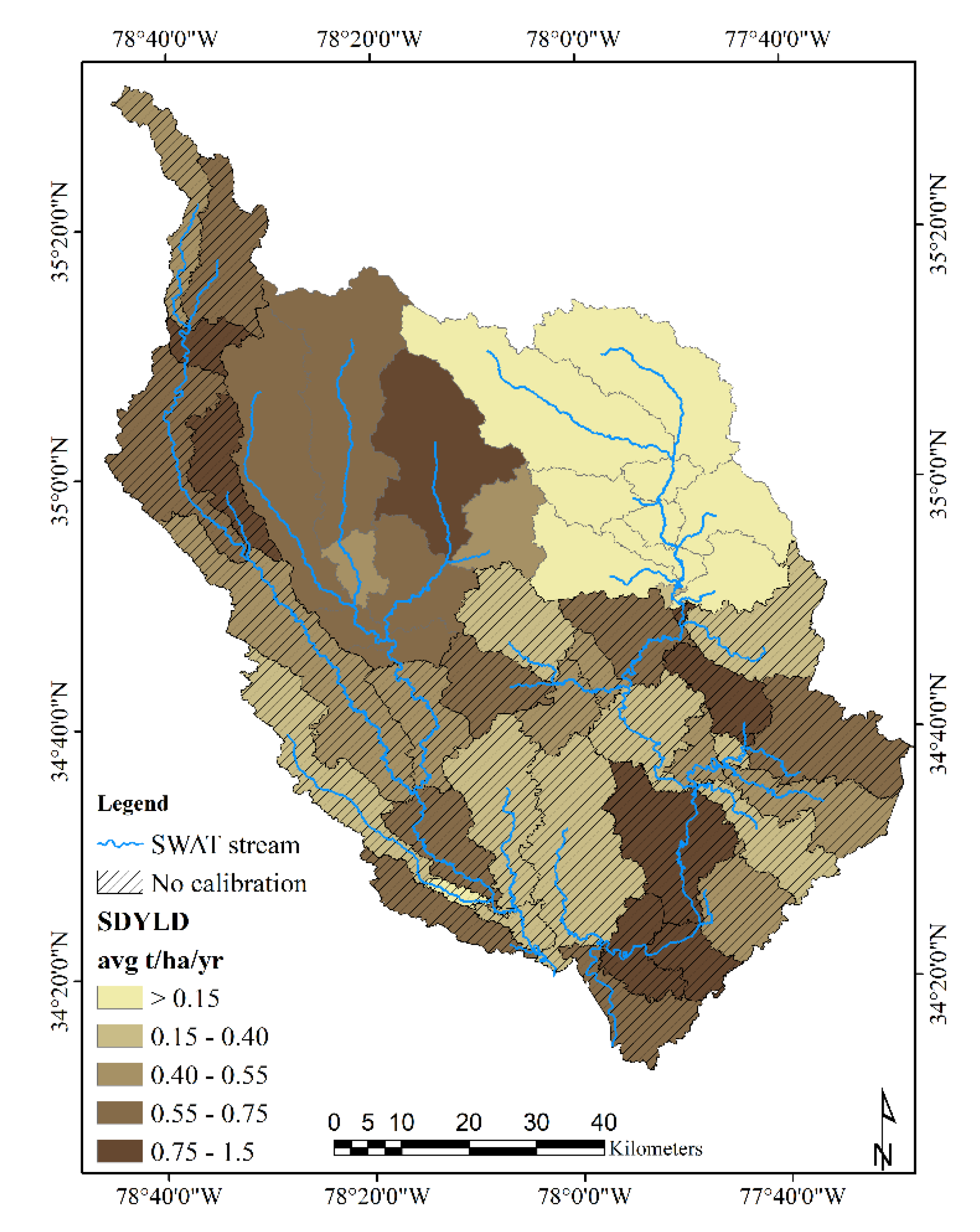1. Introduction
Water resource quality and quantity are increasingly managed using a watershed approach, where watersheds serve as the primary planning unit within a flexible framework that includes stakeholder involvement and management actions supported by scientific study. The watershed-based management approach is effective because it confines water resource planning to a defined geographic boundary and allows for strategies that are iterative, holistic, integrated, and collaborative [
1]. A wide range of physical, biological, ecological, socioeconomic, and policy concerns can be included in watershed management plans with the integrated approach extending beyond the hydrology [
2]. Rates of hydrologic processes can vary widely both across landscapes and throughout time due to differences in land cover, soils, and land management practices, and can make integrative, watershed-based approaches difficult to implement. Hydrologic simulation models have become an important component of watershed planning because of their ability to estimate rates of hydrologic processes at watershed scales and the ease with which they are integrated into a geographic information systems framework [
3].
Hydrologic models can contribute to developing effective watershed planning tools because they can be built using open-source data and programs and are cost-effective compared to obtaining physical measurements of hydrologic processes over large spatial or temporal scales. The integration of observed data can greatly enhance the accuracy of models, but the ability to integrate observed data is hampered when information is unknown to the modeler (such as specific rates of fertilizer application) or would require extensive time or money to collect and analyze (such as concentrations of nutrients or pesticides in soils in a large, heterogeneous river basin). Another limitation of hydrologic modeling is that it can take a great deal of time and knowledge to prepare the required data in the format required by the model, though there are now several open-source, pre-formatted datasets available that can be integrated and save time or make it easier for users to create an effective hydrologic model. Despite the limitations and challenges, hydrologic models remain a powerful watershed-level assessment tool, especially when parameterized with increasingly available high spatial and temporal resolution data.
High spatial and temporal resolution input data have been shown to enhance the accuracy of hydrologic models and, recently, satellite-based estimates of key hydrologic processes continue to boost model performance [
4,
5]. Often, depending on the goal of the model application, modelers must make a trade-off between accuracy and computation time since the inclusion of high spatial resolution data can lengthen computation time and is often very restrictive when modeling a large area. Additionally, models typically require calibration with observed hydrologic data, such as streamflow, to optimize agreement between observed and predicted values, as well as to quantify uncertainty and error in parameterization and model outputs. Calibration can take considerable processing time in models with large spatial coverage or high temporal resolution (i.e., at a daily or sub-daily time-step). Due to the financial and resource limitations that exist for many watershed managers, especially when watersheds cross administrative or political boundaries, it would be useful to develop a hydrologic model that involves minimal expenditure of time, money, and other resources. Rapid assessment models are needed to address both the lack of data, length of preparation, and resource restrictions when the overarching goal is extracting model outputs for input to a watershed management plan.
One such hydrologic model that has been widely applied for evaluating the effects of management decisions on water resource quantity and quality in large river basins, including assessments of nonpoint-source pollution, is the Soil and Water Assessment Tool (SWAT) [
6,
7]. SWAT was originally designed to operate in large, ungaged basins with little to no calibration required [
6,
7]. SWAT is a semi-distributed, physically-based river basin model that is computationally efficient and operates on a continuous time-step [
7]. SWAT is supported by ample online documentation [
8] and can be implemented in a GIS framework using a readily available toolbox. There are currently almost 2000 peer-reviewed publications that use SWAT for a multitude of purposes that can be accessed through the SWAT literature database at
https://www.card.iastate.edu/swat_articles/. Despite the relative ease of its parameterization and implementation, geographic constraints imposed by SWAT model development and its typical range of applications result in considerable challenges when attempting to quantify hydrologic processes in environments with a more complex hydrology.
Most SWAT applications to date have been performed in the middle and high latitude regions [
9,
10,
11,
12] or regions where streams are not highly influenced by groundwater interactions [
13]. Regions characterized by complex groundwater system structure and extensive groundwater–surface water interaction, such as the low-gradient, shallow-water-table-dominated systems of coastal plains or groundwater-dependent terrestrial ecosystems, are not as well represented in the literature. Accurate representation of the physical conditions in regions with high water tables, such as saturated or near-saturated soil profiles, complexities in soil storage capacity, or considerable wetland and riparian storage, can be difficult. The application of SWAT in low-gradient regions with extensive groundwater–surface water interactions, such as the southeastern U.S. Coastal Plain, has increased in recent years, but it remains an underdeveloped area of study. Models in this region have resulted in varying degrees of accuracy in predicting hydrologic processes such as streamflow [
3,
4,
14,
15,
16,
17,
18,
19], runoff [
4,
14,
20], and potential and/or actual evapotranspiration rates [
4,
18]. Difficulties specifically associated with modeling Coastal Plain watersheds arise due to the flat topography, extensive groundwater–surface water interactions, as well as the seasonal variations and physical and temporal heterogeneity in precipitation and evapotranspiration rates within these environments [
3,
4,
15].
Challenges associated with creating an accurate hydrologic model of regions characterized by extensive groundwater–surface water interactions include the selection and preparation of climatic data. The availability of climatic data at timescales and time steps able to resolve the high spatial and temporal heterogeneity of climatic inputs, especially precipitation, can be severely limited and sometimes non-existent [
5]. If rain-gage data is available, it may provide poor representation of the spatial distribution of precipitation throughout the watershed because it is effectively a point measurement oftentimes applied to large areas [
21]. Often, observed rain and temperature gage records exist but are incomplete. When observed weather records are missing, SWAT will generate values that can often be quite poor, especially if the climate statistics in the SWAT weather generator are poorly parameterized in the first place. Several applications of SWAT have utilized global gridded climate products known as reanalysis datasets, such as the National Centers for Environmental Prediction (NCEP) Climate Forecast System Reanalysis (CFSR) dataset. Models calibrated using CFSR data have been shown to provide stream discharge simulations that were as good or better than models that used traditional weather gage measurements [
21,
22] and potential evapotranspiration (PET) estimates that compared well with observed data [
23]. Dile and Srinivasan [
24] found that models created with CFSR yielded minor differences in water balance components compared to models created with conventional climate gage data, with an exception for one watershed where the CFSR models drastically overestimated the annual average rainfall compared to conventional models. Similarly, Grusson et al. [
25] found CFSR to perform well at some locations while overestimating precipitation in others. Despite these known issues, because CFSR data is available to download pre-formatted for SWAT (
http://globalweather.tamu.edu/), it is easily and effectively integrated into SWAT models and generally performs satisfactorily.
One of the largest challenges associated with creating accurate hydrologic models of Coastal Plains watersheds is representing processes controlled by land use or changes in land use in the watershed, where spatial variation in hydrologic processes or land management practices are unknown or difficult to assess and quantify. For example, large swaths of the Coastal Plain are subject to intensive concentrated animal feeding operation (CAFO) land-use activities. Given that the necessary spatial or management data for CAFO operations is not made available to the public and physical data such as manure dispersal are difficult to collect, it is extremely difficult to model the relative pollution contribution of such land uses to streams and thus validate model outputs. Along with incidences of acute pollution, CAFO land use contributes pollution to streams by one of three chronic processes: (1) seepage of waste through lagoons (where it may enter shallow groundwater), (2) infiltration or runoff of lagoon effluent after it has been applied to sprayfields, and (3) erosion of soils into which nutrients are adsorbed [
26,
27,
28,
29]. Because SWAT can simulate hydrologic processes that contribute pollution to streams (such as surface runoff, percolation, and sediment erosion) at the reach, sub-watershed, or river basin levels, SWAT can aid watershed managers in developing watershed management plans that predict hydrologic conditions at relevant management scales.
In this study, we integrate pre-formatted CFSR data into a SWAT model to assess the accuracy of SWAT predictions of streamflow in two fifth-order basins in the southeastern North Carolina Coastal Plain with high densities of CAFOs. We use the SWAT Calibration and Uncertainty Program (SWAT-CUP) calibration and validation program to calibrate our model with observed monthly streamflow at two streamflow gage stations. Our specific objectives are to (1) assess accuracy, uncertainty, and parameter sensitivity by comparing observed and predicted streamflow, and (2) compare modeled values for surface runoff, percolation, and sediment erosion with values published in the literature for other Coastal Plain watersheds. This study will add to the growing body of literature that addresses the use of hydrologic cycle models in Coastal Plain watersheds, as well as will provide watershed managers with an objective method by which to estimate rates of hydrologic processes affecting ground and surface water and aid in the development of integrated watershed management plans.
4. Conclusions
The results from our multi-year SWAT model calibration and validation demonstrate the effectiveness of incorporating gridded precipitation products into hydrological assessment models within the Atlantic Coastal Plain. Our model is the first of its kind to simultaneously assess streamflow, runoff, percolation, and sediment loss rate estimations using daily CFSR gridded climate data, and one of few studies that utilizes CFSR in Coastal Plain watersheds. Our model improves on previous rate estimations of runoff, percolation, and sediment loss by providing basin- and sub-watershed-specific estimates as opposed to estimates for the larger southeastern Atlantic Coastal Plain. Streamflow predictions at two gages resulted in acceptable results for the two-year calibration period (NSE = 0.67 and 0.60) and very good results during the two-year validation period (NSE = 0.84 and 0.91). SWAT model estimates for runoff, percolation, and sediment yield were all within reasonable ranges for this region of the Coastal Plain. However, estimates for the uncalibrated portions of the study area are more uncertain due to the inability to calibrate the model and tidal influence within these areas, due to the effects that tidal influence may have on ground- and surface-water dynamics. Additionally, we provide the first SWAT parameter assessment for the Black and NECF river basins. Our parameter sensitivity results highlight the need for detailed model refinement of initial parameters that relate to groundwater or aquifer properties at higher spatial resolutions for shallow water-table dominated hydrologic systems. Additionally, improvements are needed to the potential evapotranspiration estimates to further refine model predictions.
Long-term hydrologic models, as presented here, are a critical source of the scientifically-based information needed to make sound management decisions that sustain and protect the quality of regional water resources. The study results point to the utility of incorporating gridded climate products such as CFSR for hydrologic models in shallow-aquifer-dominated Coastal Plains systems where observational gage records are incomplete or inaccurately represent large-scale precipitation patterns. Our model provides the basis for future model development and parameterization refinement in the Black and NECF basins in support of regional watershed management plans. Further research is also needed to evaluate the effects of changes in climate or land use on dominant hydrologic processes within this region, as well as assessing model improvement through the incorporation of remotely sensed hydrologic data, such as ET or soil moisture.











